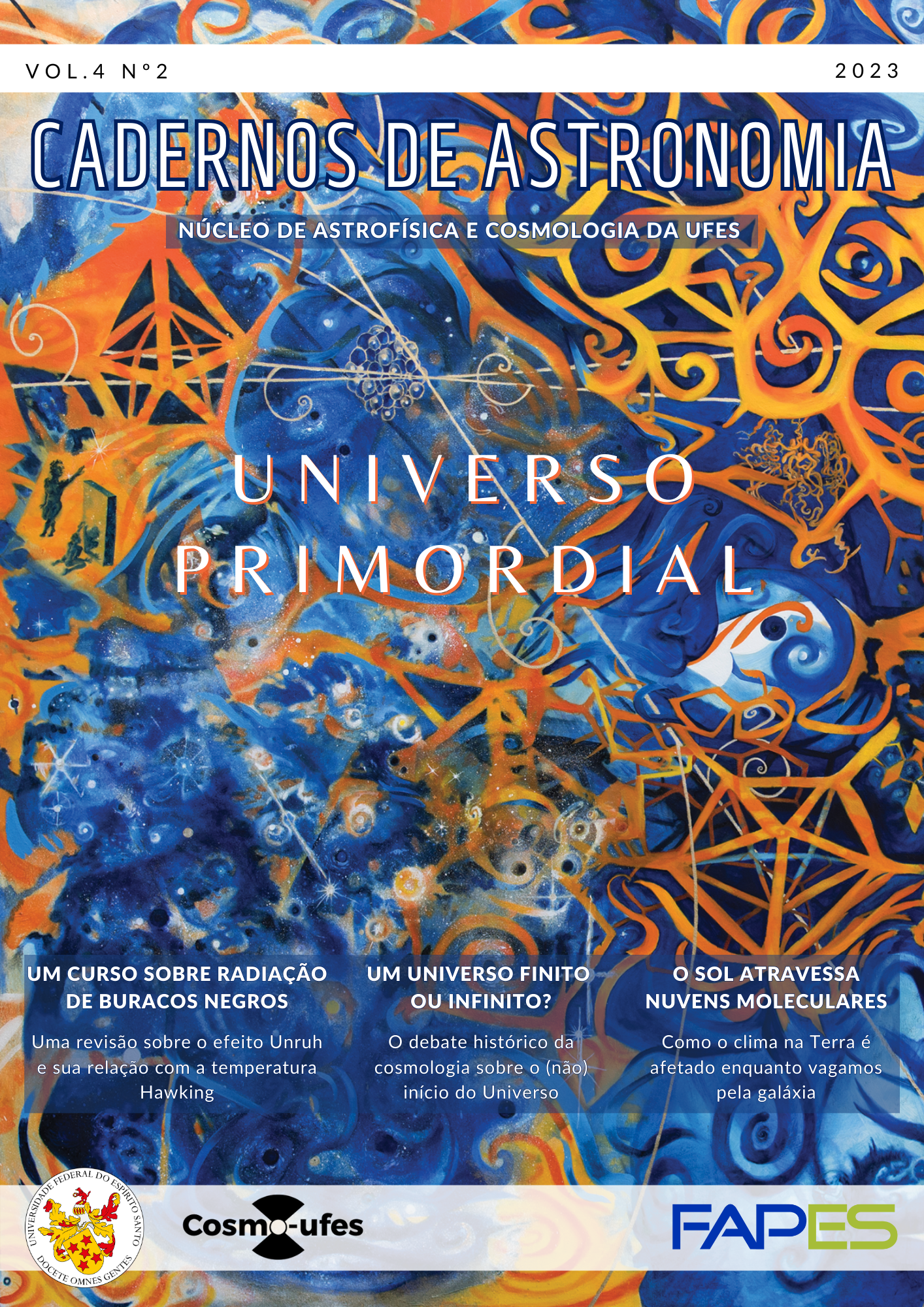O Modelo de inflação: progressos e desafios
DOI:
https://doi.org/10.47456/Cad.Astro.v4n2.41170Palabras clave:
Cosmologia, Universo primordial, radiação cósmica de fundo, inflação cosmológicaResumen
...
Referencias
S. Tsujikawa, Introductory review of cosmic inflation, in 2nd Tah Poe School on Cosmology: Modern Cosmology (2003). ArXiv: hep-ph/0304257.
H. Kragh, Cosmology and Controversy (Princeton University Press, Princeton, 1999).
H. Kragh, The Big Bang (W. H. Freeman & Co., New York, 2001).
S. Weinberg, The First Three Minuts (revised edition) (Perseus Books, New York, 1993).
N. Aghanim et al., Planck 2018 results. VI. Cosmological parameters, Astron. Astrophys. 641, A6 (2020), [Erratum: Astron.Astrophys. 652, C4 (2021)]. ArXiv:1807.06209.
A. H. Guth, The Inflationary Universe: A Possible Solution to the Horizon and Flatness Problems, Phys. Rev. D 23, 347 (1981).
K. Sato, First Order Phase Transition of a Vacuum and Expansion of the Universe, Mon. Not. Roy. Astron. Soc. 195, 467 (1981).
A. Berera, I. G. Moss e R. O. Ramos, Warm Inflation and its Microphysical Basis, Rept. Prog. Phys. 72, 026901 (2009). ArXiv:0808.1855.
A. H. Guth e E. J. Weinberg, Could the Universe Have Recovered from a Slow First Order Phase Transition?, Nucl. Phys. B 212, 321 (1983).
A. D. Linde, A New Inflationary Universe Scenario: A Possible Solution of the Horizon, Flatness, Homogeneity, Isotropy and Primordial Monopole Problems, Phys. Lett. B 108, 389 (1982).
A. Albrecht e P. J. Steinhardt, Cosmology for Grand Unified Theories with Radiatively Induced Symmetry Breaking, Phys. Rev. Lett. 48, 1220 (1982). Referências
A. D. Linde, Chaotic Inflation, Phys. Lett. B 129, 177 (1983).
T. Biswas et al., Cosmological perturbations from statistical thermal fluctuations, Phys. Rev. D 88(2), 023517 (2013). ArXiv:1302.6463.
L. L. Graef, Constraining the spectrum of cosmological perturbations from statistical thermal fluctuations, Phys. Lett. B 819, 136418 (2021).
B. Ryden, Introduction to Cosmology (second edition) (Ohio State University, Ohio, 2016).
D. Baumann, Cosmology (Cambridge University Press, 2022).
V. Mukhanov, Physical Foundations of Cosmology (Cambridge University Press, Oxford, 2005).
S. Dodelson, Modern Cosmology (Academic Press, Amsterdam, 2003).
S. Weinberg, Cosmology (Oxford University Press, Oxford, 2008).
R. Brandenberger e P. Peter, Bouncing Cosmologies: Progress and Problems, Found. Phys. 47(6), 797 (2017). ArXiv:1603.05834.
N. Pinto Neto, Perturbations in bouncing cosmological models, Int. J. Mod. Phys. D 13, 1419 (2004). ArXiv:hep-th/0410225.
M. Novello e S. E. P. Bergliaffa, Bouncing Cosmologies, Phys. Rept. 463, 127 (2008). ArXiv:0802.1634.
L. L. Graef et al., Dynamics of Cosmological Perturbations and Reheating in the Anamorphic Universe, JCAP 04, 004 (2017). ArXiv:1701.02654.
J. Khoury et al., The Ekpyrotic universe: Colliding branes and the origin of the hot big bang, Phys. Rev. D 64, 123522 (2001). ArXiv:hep-th/0103239.
R. H. Brandenberger, Principles, progress and problems in inflationary cosmology, AAPPS Bull. 11, 20 (2001). ArXiv: astro-ph/0208103.
J. Martin e R. H. Brandenberger, The TransPlanckian problem of inflationary cosmology, Phys. Rev. D 63, 123501 (2001). ArXiv: hep-th/0005209.
E. G. M. Ferreira e R. Brandenberger, The Trans-Planckian Problem in the Healthy Extension of Horava-Lifshitz Gravity, Phys. Rev. D 86, 043514 (2012). ArXiv:1204.5239.
A. Ashtekar e E. Bianchi, A short review of loop quantum gravity, Rept. Prog. Phys. 84(4), 042001 (2021). ArXiv:2104.04394.
I. Agullo e P. Singh, Loop Quantum Cosmology (WSP, 2017), 183–240. ArXiv:1612.01236.
G. S. Vicente, R. O. Ramos e L. L. Graef, Gravitational particle production and the validity of effective descriptions in loop quantum cosmology, Phys. Rev. D 106(4), 043518 (2022). ArXiv:2207.00435.
A. H. Guth, Eternal inflation and its implications, J. Phys. A 40, 6811 (2007). ArXiv: hep-th/0702178.
A. Ijjas, P. J. Steinhardt e A. Loeb, Inflationary paradigm in trouble after Planck2013, Phys. Lett. B 723, 261 (2013). ArXiv:1304.2785.
A. H. Guth, D. I. Kaiser e Y. Nomura, Inflationary paradigm after Planck 2013, Phys. Lett. B 733, 112 (2014). ArXiv:1312.7619.
A. Linde, Inflationary Cosmology after Planck , in Post-Planck Cosmology: Lecture Notes of the Les Houches Summer School: Volume 100, July 2013, editado por C. Deffayet et al. (2015), 230–316. ArXiv:1402.0526.
A. Ijjas, P. J. Steinhardt e A. Loeb, Inflationary schism, Phys. Lett. B 736, 142 (2014). ArXiv:1402.6980.
P. Ade et al., The Simons Observatory: Science goals and forecasts, JCAP 02, 056 (2019). ArXiv:1808.07445.
K. N. Abazajian et al., CMB-S4 Science Book, First Edition (2016). ArXiv:1610.02743.
S. Hanany et al., PICO: Probe of Inflation and Cosmic Origins (2019). ArXiv:1902.10541.
D. Paoletti, The LiteBIRD mission, PoS ICHEP2022, 085 (2022).
Descargas
Publicado
Número
Sección
Licencia
Derechos de autor 2023 Leila Lobato Graef

Esta obra está bajo una licencia internacional Creative Commons Atribución 4.0.






